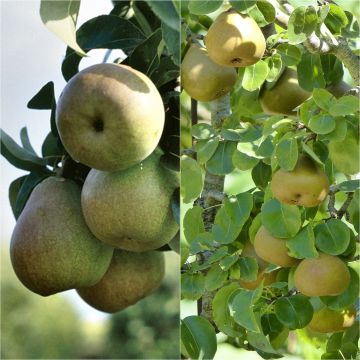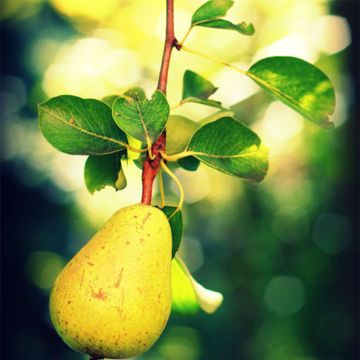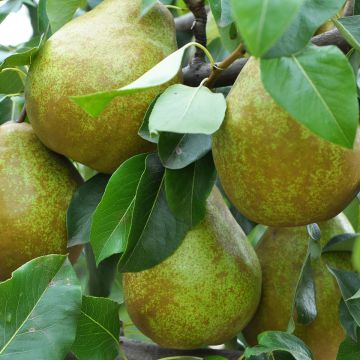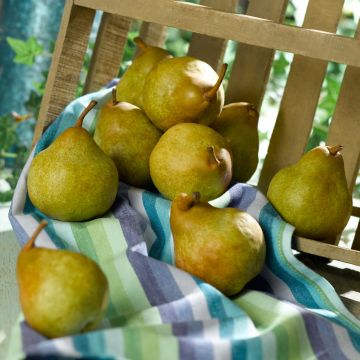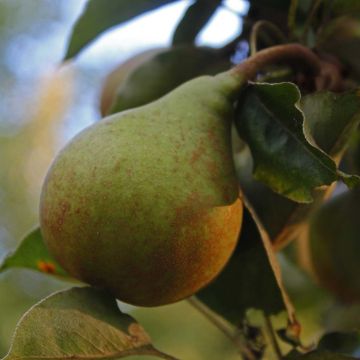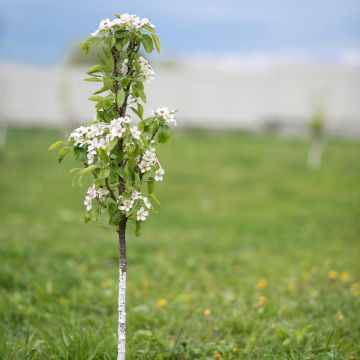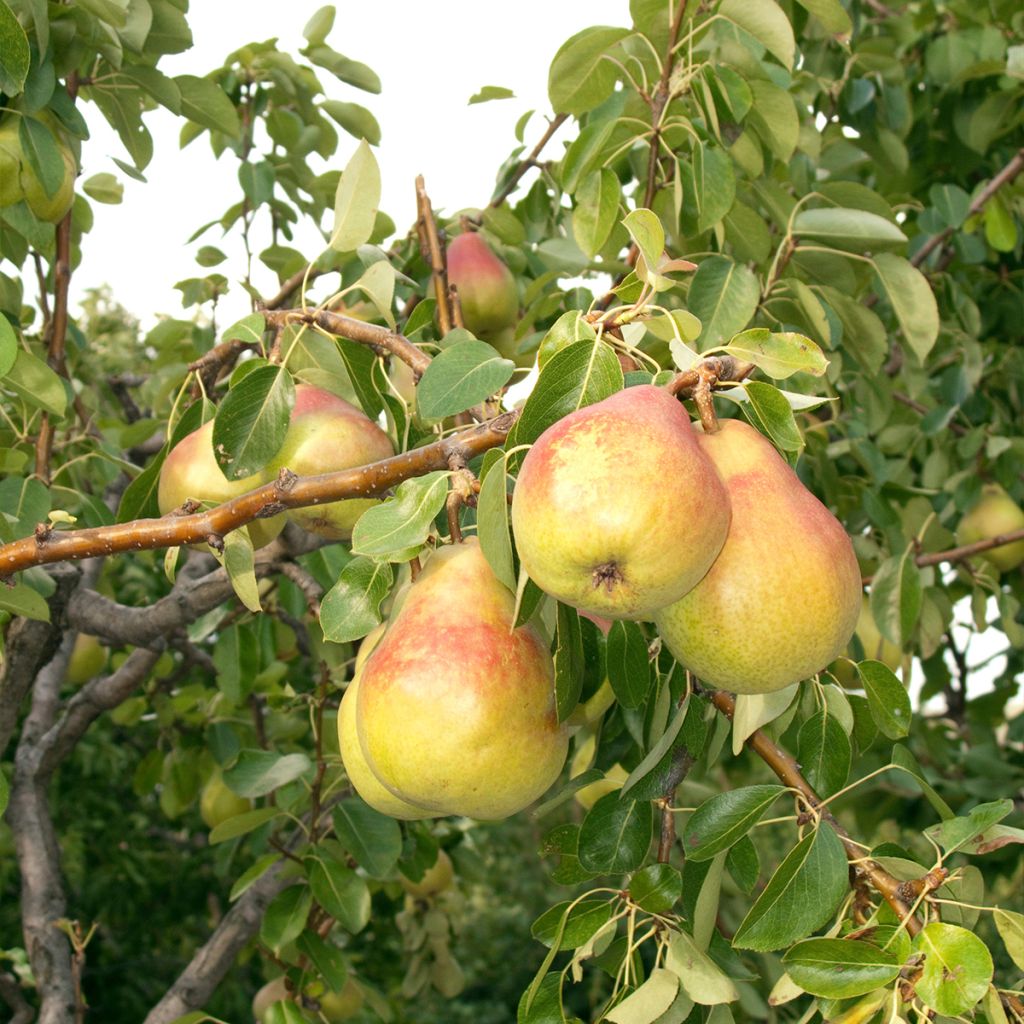

Pyrus communis Clapp’s Favorite - Pear Tree
Pyrus communis Clapp’s Favorite - Pear Tree
Pyrus communis Clapp’s Favorite
Common Pear, European Pear
I am disappointed to receive a pear tree (from a nursery) with black spots on a good part of the leaves. The spots have spread! At least stores like Castorama offer a discount... Yours faithfully, Annick
Annick, 14/05/2024
This item cannot be shipped to the selected country
Oversize package delivery charge from €6.90
Oversize package delivery charge from €6.90
Oversize package delivery charge from €6.90
Oversize package delivery charge from €6.90
Delivery to Corse prohibited
More information
Schedule delivery date,
and select date in basket
This plant carries a 6 months recovery warranty
More information
We guarantee the quality of our plants for a full growing cycle, and will replace at our expense any plant that fails to recover under normal climatic and planting conditions.
Oversize package: home delivery by special carrier from €6.90 per order..
Express home delivery from €8.90.
Oversize package: home delivery by special carrier from €6.90 per order..
Express home delivery from €8.90.
Oversize package: home delivery by special carrier from €6.90 per order..
Express home delivery from €8.90.
Oversize package: home delivery by special carrier from €6.90 per order..
Express home delivery from €8.90.
Delivery to Corse prohibited: UE law prohibits the import of this plant from mainland France to Corse as part of the fight against Xylella fastidiosa. Please accept our sincere apologies.
More information
Description
Pyrus communis Clapp's Favorite or Fruhe Clapps is an old American variety, hardy, vigorous, resistant to scab, producing fruits of excellent taste quality, much appreciated by pear enthusiasts. The fruit is large, pear-shaped, more or less elongated. Its skin is smooth, thin, yellow-green, widely washed with red-purple on the sunny side. Its white-yellow flesh is fine, melting, juicy, sweet, tangy, and fragrant. Harvesting takes place from late August and extends over 4 to 6 weeks. Not suitable for long-term storage, the fruits are consumed as they ripen. Pleasantly tangy and rich in sugar, it is a delicious pear to enjoy fresh. When cooked, it is a variety that lends itself well to many sweet or savoury recipes. Can be grown at high altitudes. It is a partially self-fertile variety that requires the presence of other pear varieties nearby to improve pollination and increase the number of fruits.
Pyrus communis (Common Pear) is a fruit tree belonging to the Rosaceae family. Present in Europe since ancient times, it originated from forests in Western Asia. Over the centuries, a very large number of cultivars have emerged. Its cultivation is widely spread in Europe. Derived from a seedling of the Fondante des Bois variety, Clapp's Favorite, also known as Fruhe Clapps, was obtained by Mr. Thaddeus Clapp in 1860 in Boston (Dorchester Quarter) in the state of Massachusetts (United States).
The Clapp's Favorite Pear tree is a semi-erect tree with a framework that can reach 4 to 6 metres (13 to 20 feet) in height, producing many strong and slightly arched branches. Its pyramidal habit is well-suited for tall forms (on a trunk) or low forms (bush shape) or espaliers (fan shape). Its deciduous foliage consists of large, alternate, ovate leaves, 8 to 10cm (3 to 4in) long, shiny green with yellow-orange autumn hues. Flowering occurs quite late in April to early May, which generally protects it from frost. The white flowers, single, 2 to 3cm (1in) in diameter, grouped in umbels, are nectariferous. They can be destroyed by frost starting at -2 to -3°C. It is a hardy tree that withstands temperatures around -25°C, and it is suitable for cultivation in most regions, including at high altitudes. This Pear tree is self-sterile or self-incompatible, as the flowers cannot fertilise themselves. As such the presence of other pear varieties in close proximity, which flower at the same time, is necessary. For example, the varieties Charneux, Conference, Doyenne du Comice, Beurre Hardy, Louise Bonne d'Avranches, Triomphe de Vienne, Williams, William's Rouge are suitable for cross-pollination and thus increase the number of fruits.
The Clapp's Favorite Pear tree is a high-yielding variety with quick fruiting. Abundant and regular fruiting begins from late August and extends until the end of September. The fruits are consumed as they ripen. The pear can be consumed raw or cooked, in compotes, pastries, and desserts, in fruit salads or mixed salads, in combination with cheeses or as an accompaniment to savoury dishes, alongside duck, white meats (poultry and lamb), or game. It is also perfect for making juices or fruits in syrup. Rich in water, the pear is refreshing and thirst-quenching. Very fleshy, it provides a great feeling of satiety. Moderately caloric, it is rich in potassium, calcium, and magnesium, with a significant iron content. Its content of vitamins C and E, antioxidants, and fibres make the pear a health asset. It is invigorating, energising, and rehydrating. The fruits have a short shelf life, so it is best to consume them as they ripen. Storage can be done in a cool, dry place, protected from light, at a temperature of around 8 to 10°C or in a cold room, airtight from the outside air, at a temperature of 1 to 3°C.
In the Pear Trees category, the Pyrus communis Clapp's Favorite is a hardy and vigorous variety, very resistant to scab. This fruit tree likes fresh and deep soils, but it dislikes excessively draining and calcareous soils. In order to obtain fruits of good quality, thinning should be practiced by reducing the number of fruits on the tree. Pruning for better aeration, by removing some branches in the centre of the tree, will provide light and give the fruits a beautiful colouration. This will also limit the occurrence of diseases. Very popular thanks to its fruit, the pear tree finds its place in the garden for the pleasure of young and old. With a wide range of varieties, it is easy to find the one that best suits your taste.
Report an error about the product description
Pyrus communis Clapp’s Favorite - Pear Tree in pictures
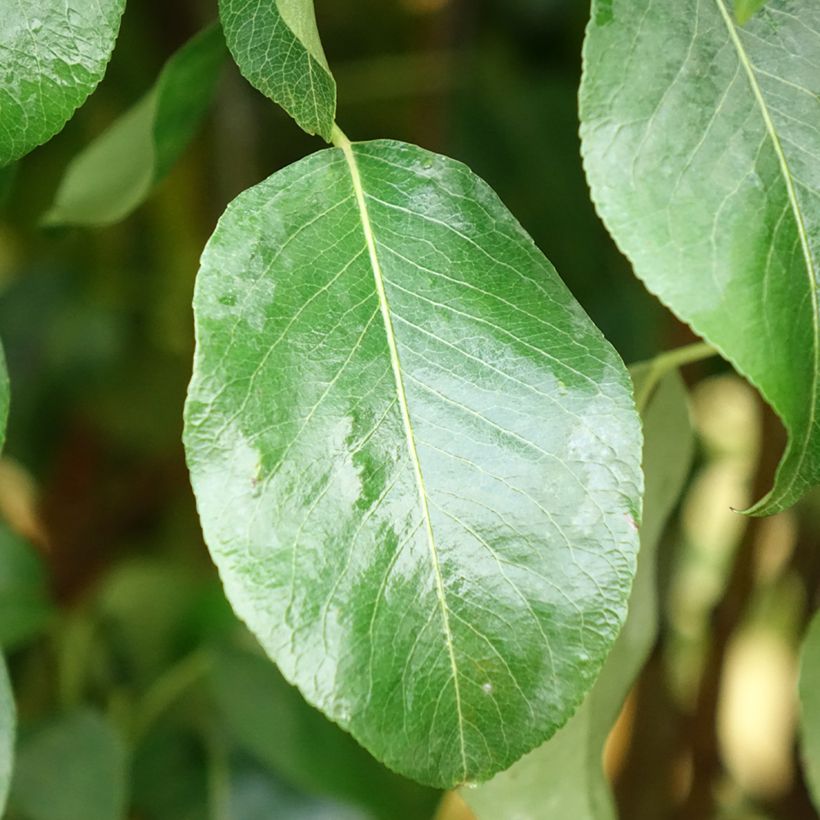

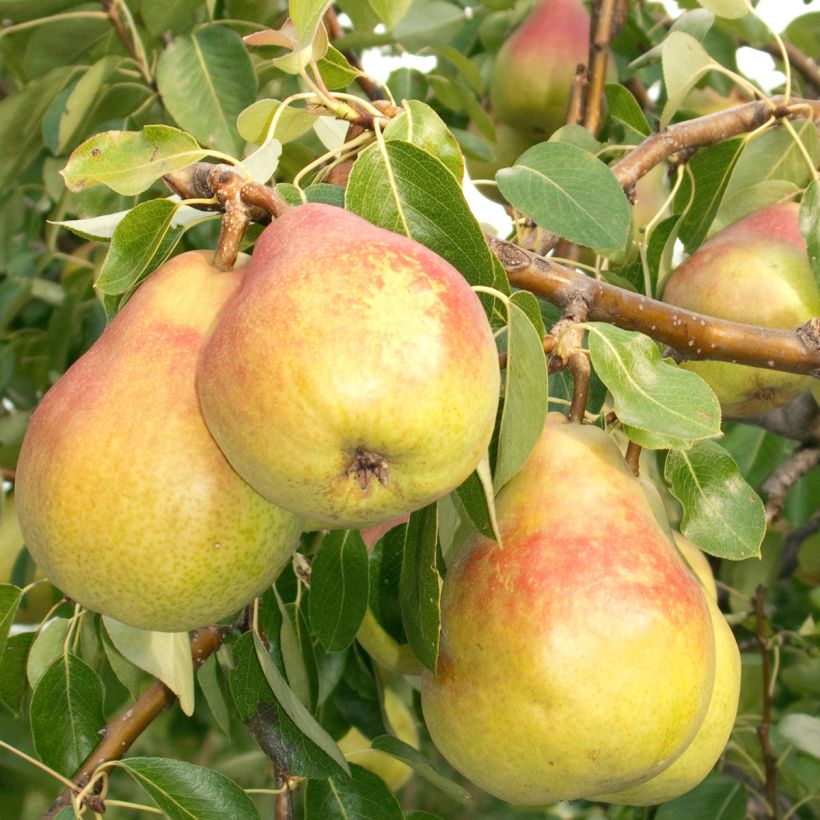

Plant habit
Fruit
Flowering
Foliage
Botanical data
Pyrus
communis
Clapp’s Favorite
Rosaceae
Common Pear, European Pear
Cultivar or hybrid
Other Pear trees
Planting and care
Your Clapp's Favorite Pear Tree, needing warmth, will be planted sheltered from prevailing winds, especially in cooler regions, and preferably in full sun. The pear tree thrives in rich soils, slightly moist but without stagnant moisture; it does not tolerate overly dry or alkaline soils. Pear trees, like all fruit trees, are ideally planted between October and March, outside of freezing periods. Container-grown trees can be planted throughout the year, except during periods of high heat or frost.
To plant, loosen the soil deeply and remove rocks and unwanted weeds. Add some gravel to improve drainage if necessary. Dig a large planting hole at least 3 times the volume of the root ball. Make sure to separate the subsoil from the topsoil. Mix crushed horn and organic matter (potting soil, compost, etc.) with the subsoil and pour this mixture into the bottom of the planting hole. Place the root ball, cover with topsoil without burying the graft point, and firm the soil. Water generously (about 10 litres). It may be beneficial to stake the pear tree by installing a guy-wire system: plant 3 stakes in a triangle 50cm (20in) away from the trunk and connect them together with pieces of wood. Protect the bark with a piece of rubber, for example, and attach the stakes to the trunk with wire. It is also possible to espalier it on a support (U-shaped espalier or Verrier espalier, for example).
For maintenance, apply well-rotted compost on the surface every year in autumn. Then in winter, add a small shovelful of wood ash, rich in potash, to improve fruiting. Hoe if necessary at the base of the tree. Water regularly, depending on your climate, during the first two or three years.
The pear tree can be susceptible to various diseases and pests. Against scab (brown spots on the leaves), brown rot (wilting of flowers and rotting of fruits on the tree), and powdery mildew (white powdery coating on the leaves), spray preventive doses of Bordeaux mixture and extract of horsetail. As for pests, the codling moth or fruit worm, a small caterpillar, can be controlled by installing bird and bat boxes, by placing undulated cardboard strips along the trunk, and by bagging the fruits in brown kraft paper. In case of aphid infestation, spray a mixture of water and black soap.
Planting period
Intended location
Care
-
, onOrder confirmed
Reply from on Promesse de fleurs
Haven't found what you were looking for?
Hardiness is the lowest winter temperature a plant can endure without suffering serious damage or even dying. However, hardiness is affected by location (a sheltered area, such as a patio), protection (winter cover) and soil type (hardiness is improved by well-drained soil).

Photo Sharing Terms & Conditions
In order to encourage gardeners to interact and share their experiences, Promesse de fleurs offers various media enabling content to be uploaded onto its Site - in particular via the ‘Photo sharing’ module.
The User agrees to refrain from:
- Posting any content that is illegal, prejudicial, insulting, racist, inciteful to hatred, revisionist, contrary to public decency, that infringes on privacy or on the privacy rights of third parties, in particular the publicity rights of persons and goods, intellectual property rights, or the right to privacy.
- Submitting content on behalf of a third party;
- Impersonate the identity of a third party and/or publish any personal information about a third party;
In general, the User undertakes to refrain from any unethical behaviour.
All Content (in particular text, comments, files, images, photos, videos, creative works, etc.), which may be subject to property or intellectual property rights, image or other private rights, shall remain the property of the User, subject to the limited rights granted by the terms of the licence granted by Promesse de fleurs as stated below. Users are at liberty to publish or not to publish such Content on the Site, notably via the ‘Photo Sharing’ facility, and accept that this Content shall be made public and freely accessible, notably on the Internet.
Users further acknowledge, undertake to have ,and guarantee that they hold all necessary rights and permissions to publish such material on the Site, in particular with regard to the legislation in force pertaining to any privacy, property, intellectual property, image, or contractual rights, or rights of any other nature. By publishing such Content on the Site, Users acknowledge accepting full liability as publishers of the Content within the meaning of the law, and grant Promesse de fleurs, free of charge, an inclusive, worldwide licence for the said Content for the entire duration of its publication, including all reproduction, representation, up/downloading, displaying, performing, transmission, and storage rights.
Users also grant permission for their name to be linked to the Content and accept that this link may not always be made available.
By engaging in posting material, Users consent to their Content becoming automatically accessible on the Internet, in particular on other sites and/or blogs and/or web pages of the Promesse de fleurs site, including in particular social pages and the Promesse de fleurs catalogue.
Users may secure the removal of entrusted content free of charge by issuing a simple request via our contact form.
The flowering period indicated on our website applies to countries and regions located in USDA zone 8 (France, the United Kingdom, Ireland, the Netherlands, etc.)
It will vary according to where you live:
- In zones 9 to 10 (Italy, Spain, Greece, etc.), flowering will occur about 2 to 4 weeks earlier.
- In zones 6 to 7 (Germany, Poland, Slovenia, and lower mountainous regions), flowering will be delayed by 2 to 3 weeks.
- In zone 5 (Central Europe, Scandinavia), blooming will be delayed by 3 to 5 weeks.
In temperate climates, pruning of spring-flowering shrubs (forsythia, spireas, etc.) should be done just after flowering.
Pruning of summer-flowering shrubs (Indian Lilac, Perovskia, etc.) can be done in winter or spring.
In cold regions as well as with frost-sensitive plants, avoid pruning too early when severe frosts may still occur.
The planting period indicated on our website applies to countries and regions located in USDA zone 8 (France, United Kingdom, Ireland, Netherlands).
It will vary according to where you live:
- In Mediterranean zones (Marseille, Madrid, Milan, etc.), autumn and winter are the best planting periods.
- In continental zones (Strasbourg, Munich, Vienna, etc.), delay planting by 2 to 3 weeks in spring and bring it forward by 2 to 4 weeks in autumn.
- In mountainous regions (the Alps, Pyrenees, Carpathians, etc.), it is best to plant in late spring (May-June) or late summer (August-September).
The harvesting period indicated on our website applies to countries and regions in USDA zone 8 (France, England, Ireland, the Netherlands).
In colder areas (Scandinavia, Poland, Austria...) fruit and vegetable harvests are likely to be delayed by 3-4 weeks.
In warmer areas (Italy, Spain, Greece, etc.), harvesting will probably take place earlier, depending on weather conditions.
The sowing periods indicated on our website apply to countries and regions within USDA Zone 8 (France, UK, Ireland, Netherlands).
In colder areas (Scandinavia, Poland, Austria...), delay any outdoor sowing by 3-4 weeks, or sow under glass.
In warmer climes (Italy, Spain, Greece, etc.), bring outdoor sowing forward by a few weeks.

































